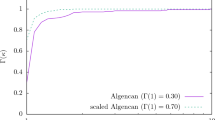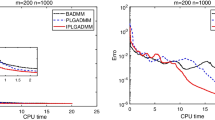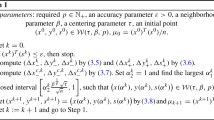Abstract
Deterministic global optimization with interval analysis involves
• using interval enclosures for ranges of the constraints, objective, and gradient to reject infeasible regions, regions without global optima, and regions without critical points;
• using interval Newton methods to converge on optimum-containing regions and to verify global optima.
There are certain problems for which interval dependency leads to overestimation in the enclosures of the individual components, causing the optimization search to become prohibitively inefficient. As Hansen has observed earlier, in other problems, there is no overestimation in the individual components, but overestimation is introduced in the preconditioning in the interval Newton method.
We examine these issues for a particular nonlinear systems problem that, to date, has defied numerical solution. To reduce overestimation, we use Taylor models. The Taylor models sometimes reduce individual overestimation but, consistent with Hansen's observations, especially reduce the overestimation due to preconditioning. From numerical experiments, we conclude that, in certain instances, Taylor models can greatly reduce both the number of subregions necessary to complete an exhaustive search and the total computational effort.
Similar content being viewed by others
References
Berz, M.: COSY INFINIT web page, <http://cosy.pa.msu.edu/,2000>.
Berz, M. and Hoffstätter, G.: Computation and Application of Taylor Polynomials with Interval Remainder Bounds, Reliable Computing 4 (1) (1998), pp. 83-97.
Berz, M., Makino, K., Shamseddine, K., Hoffstätter, G. H., and Wan, W.: COSY INFINITY and Its Applications in Nonlinear Dynamics, in: Computational Differentiation, Techniques, Applications, and Tools, SIAM, Philadelphia, 1996, pp. 363-365.
Corliss, G. F.: GlobSol entry page, http://www.mscs.mu.edu/~globsol/,1998.
Corliss, G. F. and Kearfott, R. B.: Rigorous Global Search: Industrial Applications, in: Developments in Reliable Computing, Kluwer Academic Publishers, Dordrecht, 2000, pp. 1-16.
Hansen, E. R.: Preconditioning Linearized Equations, Computing 58 (1997), pp. 187-196.
Hertling, P.: A Limitation for Underestimation via Twin Arithmetic, Reliable Computing 7 (2) (2001), pp. 157-169.
Hoefkens, J.: Rigorous Numerical Analysis with High-Order Taylor Models, Ph.D. thesis, Department of Mathematics, Michigan State University, 2001.
Kearfott, R. B.: A Fortran 90 Environment for Research and Prototyping of Enclosure Algorithms for Nonlinear Equations and Global Optimization, ACM Trans. Math. Software 21 (1) (1995), pp. 63-78.
Kearfott, R. B.: Empirical Evaluation of Innovations in Interval Branch and Bound Algorithms for Nonlinear Algebraic Systems, SIAM J. Sci. Comput. 18 (2) (1997), pp. 574-594.
Kearfott, R. B.: Rigorous Global Search: Continuous Problems, Kluwer Academic Publishers, Dordrecht, 1996.
Kearfott, R. B. and Arazyan, A.: Taylor Series Models in Deterministic Global Optimization, in: Proceedings of Automatic Differentiation 2000: From Simulation to Optimization, Springer-Verlag, New York, 2000.
Kearfott, R. B., Dawande, M., Du, K.-S., and Hu, C.-Y.: Algorithm 737: INTLIB, A Portable FORTRAN 77 Interval Standard Function Library, ACM Trans. Math. Software 20 (4) (1994), pp. 447-459.
Makino, K. and Berz, M.: Efficient Control of the Dependency Problem Based on Taylor Model Methods, Reliable Computing 5 (1) (1999), pp. 3-12.
Makino, K. and Berz, M.: New Applications of Taylor Methods, in: Proceedings of Automatic Differentiation 2000: From Simulation to Optimization, Springer-Verlag, New York, 2000.
Muñoz, H.: Interval Slopes and Twin Slope Arithmetic in Nonsmooth Optimization, Ph.D. thesis, University of Louisiana at Lafayette, 2001.
Nesterov, V. M.: Interval and Twin Arithmetics, Reliable Computing 3 (4) (1997), pp. 369-380.
Neumaier, A.: Interval Methods for Systems of Equations, Cambridge University Press, Cambridge, 1990.
Pardalos, P. M. and Rosen, J. B.: Constrained Global Optimization: Algorithms and Applications, Lecture Notes in Computer Science 268, Springer-Verlag, New York, 1987.
Ratschek, H. and Rokne, J.: New Computer Methods for Global Optimization, Wiley, New York, 1988.
Ratz, D. and Csendes, T.: On the Selection of Subdivision Directions in Interval Branch-and-Bound Methods for Global Optimization, J. Global Optim. 7 (1995), pp. 183-207.
Van Hentenryck, P., Michel, L., and Deville, Y.: Numerica: A Modeling Language for Global Optimization, MIT Press, Cambridge, 1997.
Author information
Authors and Affiliations
Rights and permissions
About this article
Cite this article
Kearfott, R.B., Walster, G.W. Symbolic Preconditioning with Taylor Models: Some Examples. Reliable Computing 8, 453–468 (2002). https://doi.org/10.1023/A:1021364526413
Issue Date:
DOI: https://doi.org/10.1023/A:1021364526413




